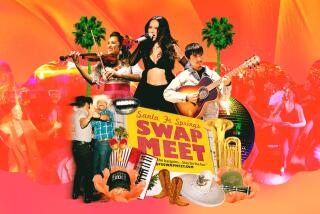Salsa sings the blues as it hits a big slump
To get a glimpse of how far and fast tropical music has fallen, consider the careening career of onetime merengue sensation Elvis Crespo.
Four years ago, the shaggy-haired singer was the unlikely headliner of the annual salsa festival at the Hollywood Bowl. His debut platinum album with the monotonic novelty hit ‚ÄúSuavemente‚ÄĚ had catapulted his billing above icons such as Celia Cruz and Oscar D‚ÄôLeon. He made the 1999 event the biggest in the history of the festival, L.A‚Äô.s premier salsa showcase for almost a decade.
Today the young Puerto Rican’s popularity has plummeted. He is scheduled for a return engagement here next month, but in far less stellar circumstances: The crestfallen Crespo will be playing the bingo hall at the San Manuel Indian Casino in San Bernardino County.
Of course, every genre has its one-hit wonders. But Crespo’s case points to much deeper troubles for tropical music, or salsa, the catchall term for a variety of Afro-Caribbean styles.
To put it mildly, salsa is in a slump. The once-vibrant genre that has captivated audiences around the world for decades has suddenly become a backwater business, with a declining market share and extremely uncertain prospects.
In its 100-year history, Afro-Caribbean music has had its ups and downs, buffeted by forces from the Cuban revolution to the disco craze. But the crisis today is so critical that some artists, promoters and producers are starting to worry about the genre’s survival.
‚ÄúIt looks pretty bleak,‚ÄĚ says Sergio George, the veteran producer who minted the Marc Anthony sound of the early 1990s. ‚ÄúThere‚Äôs no one coming up now who seems to want to do this music.‚ÄĚ
Today young people consider salsa old-fashioned, say George and others. For the new generation of Latin performers, such as New York’s Yerba Buena or Miami’s SPAM All Stars, fusion is the future. Traditional salsa is being diluted in modern brews of house, hip-hop, pop and electronica.
Although premature reports of salsa‚Äôs death have circulated before, there are some uniquely worrisome aspects to the music‚Äôs lull in the new millennium. This is the first time in more than half a century that there is no dominant Latin label in New York City, arguably the capital of salsa. Jerry Masucci, co-founder of fabled Fania Records, which sparked the salsa boom of the ‚Äė60s and ‚Äė70s, died unexpectedly in 1997 at 62. And Ralph Mercado, owner of RMM Records and the producer of the salsa festival here, went bankrupt in the wake of legal troubles.
‚ÄúAfter the labels died, nobody took an interest in grooming new artists,‚ÄĚ says Bill Marin, a longtime record promoter with both Fania and RMM. ‚ÄúBefore, there was passion, there was direction, there was involvement in touring. There was the same kind of artist development that independent labels like Motown have done with other genres.‚ÄĚ
In the absence of new talent, the rich old catalogs keep the music alive with classics by artists such as Machito, Eddie Palmieri, Ray Barretto, Willie Colon and Ruben Blades. And the aging stars keep touring. Sixtysomething singer Cheo Feliciano delighted fans at the Conga Room earlier this month. And other excellent veterans are expected to play here in the next few weeks -- violinist Alfredo de la Fe, trombonist Jimmy Bosch and pioneering ‚Äė60s duo Richie Ray and Bobby Cruz.
Paradoxically, young fans still avidly follow the old-timers.
‚ÄúThe younger kids have discovered the old stuff, which has solos and hip arrangements and lyrics that talk about something besides romance,‚ÄĚ says pianist-bandleader Larry Harlow, who recently recruited promising young performers through a talent search on his Web site that yielded 200 hopefuls. ‚ÄúThey‚Äôre starting to realize what the real thing is.‚ÄĚ
Too bad the industry doesn’t get it.
For the past year and a half, Harlow has been holding back a double CD and DVD of his 35th anniversary concert in Puerto Rico. He‚Äôs asking $150,000 from labels for the live material, but he‚Äôs had no takers. ‚ÄúIt‚Äôs very depressing,‚ÄĚ says Harlow, 64, a charter member of the Fania All Stars, salsa‚Äôs supergroup. ‚ÄúI‚Äôm sitting here wondering what my next profession‚Äôs going to be.‚ÄĚ
And praying for his next gig. Though he performed earlier this month before 35,000 fans during National Salsa Day in Puerto Rico, Harlow had no dates in January or February.
His dry spell starkly underscores the vanishing of New York‚Äôs once vital nightclub scene. Clubs of the so-called ‚Äúcuchifrito circuit‚ÄĚ once served as salsa incubators. Bands in the Big Apple appeared at various venues every night of the week.
Now only a handful remain. Even the weekly drum circles in New York’s Central Park are gone, banned by the city as a nuisance some six years ago.
‚ÄúThere used to be a time when to get your chops as a percussionist you had to go to Central Park for the Sunday rumbas,‚ÄĚ says Aurora Flores, a journalist and songwriter who teaches the history of Afro-Caribbean music at the City University of New York. ‚ÄúHeavy cats were jamming there. But you don‚Äôt see them anymore.‚ÄĚ
The lack of live shows deprives young musicians of their primary salsa education, says Blades, the Panamanian star who as a new arrival in New York made a point of catching the swinging Joe Cuba Sextet and his singing idol, Feliciano. Blades says albums alone can’t teach the passion and improvisational technique that apprentices pick up from watching the masters perform. Today the New York scene is so dry that bands are pleading for gigs on the West Coast, says Albert Torres, L.A.’s leading salsa concert promoter.
Here, there are several places to dance salsa, and classes are still popular. The problem is that L.A.’s salseros know their steps more than they know the artists. They don’t care who’s playing as long as they can strut their stuff.
‚ÄúBefore, it was always the two things together -- the music and the dance,‚ÄĚ says salsa radio DJ Kathy ‚ÄúLa Rumbera‚ÄĚ Diaz. ‚ÄúNow it‚Äôs all about how to look good and wear the right outfit and dance so fancy-shmancy that everybody‚Äôs looking at you, not at the musicians.‚ÄĚ
It all amounts to a dying demand for live music. The Conga Room, L.A.’s premier salsa nightclub, is booking more and more acts from other genres, such as rock en espanol.
And after eight consecutive years, there was no salsa festival last year at the Hollywood Bowl.
In the past, when the salsa scene declined in one place, it would emerge in another. Salsa hopscotched from New York to Medellin to Santo Domingo and back, absorbing unique local variations along the way.
Today, for the first time in living memory, salsa has no geographic focal point. Even in Cuba, the ‚Äė90s powerhouse, dance bands are in retreat. Havana‚Äôs premier acts, such as Los Van Van and Issac Delgado, go begging for U.S. distribution, although when items are available they fly off the shelves of Descarga.com, an Internet retailer.
‚ÄúThere‚Äôs a thirst for something that‚Äôs not being developed enough by the labels, which is younger, more vital music,‚ÄĚ says Descarga owner Bruce Polin. ‚ÄúPeople respond to the freshness of that sound, but there‚Äôs just not enough support for it.‚ÄĚ
New talent is out there, everyone agrees. Nobody thinks salsa will become extinct. But nobody knows where or in what form it will be revived.
‚ÄúWe need somebody to rock the house,‚ÄĚ says Torres, ‚Äúand everybody‚Äôs waiting to see who that‚Äôs going to be.‚ÄĚ
*
A taste of the best
For a taste of classic salsa at its best, here are some recommended upcoming concerts.
Who: Jimmy Bosch with Son Mayor
When: Thursday and Friday, 10 p.m.
Where: The Conga Room, 5364 Wilshire Blvd., L.A.
Price: $15 general, $30 reserved
Contact: (323) 938-1696
Who: Alfredo de la Fe
When: Friday, 10 p.m.
Where: Sportsmen’s Lodge, 4234 Coldwater Canyon Blvd., Studio City
Price: $15 in advance, $20 at the door
Contact: (310) 450-8770
What: 5th annual West Coast Salsa Congress featuring Oscar D’Leon, Ray Barretto with Adalberto Santiago, Richie Ray and Bobby Cruz, others.
When: May 21-25, 8 p.m nightly.
Where: Hollywood Park Casino, 3883 W. Century Blvd., Inglewood.
Price: $35 per night
Contact: (310) 450-8770
More to Read
The biggest entertainment stories
Get our big stories about Hollywood, film, television, music, arts, culture and more right in your inbox as soon as they publish.
You may occasionally receive promotional content from the Los Angeles Times.










